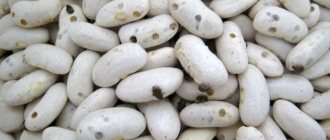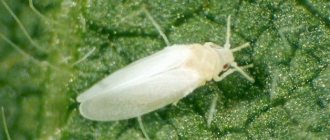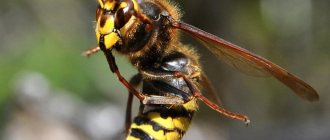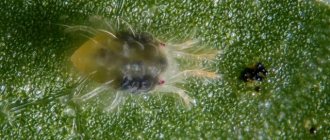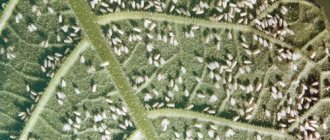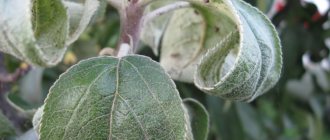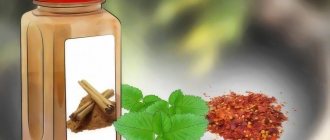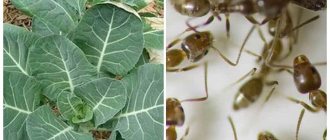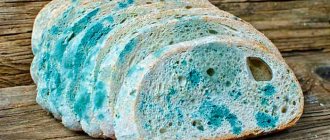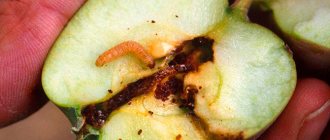Powdery mildew is one of the most common diseases in the garden. It affects absolutely everything that the fungal spores land on. But it is caused by various types of fungus that infect certain plants. For example, the pathogen Oidium tuckeri settles on grapes. Having a negative effect on shoots, leaves, flowers and berries, the fungus significantly reduces the development of the plant and can even lead to its rotting.
Another name for powdery mildew on grapes is oidium or ashtray. Fungal spores tolerate frost well, as they hide under the scales of the eyes, in the soil, under fallen leaves. In late spring, when the temperature reaches +18 °C ... +25 °C, spores wake up and begin to develop on the surface of the leaf. With increased air humidity, development occurs faster. Therefore, as a rule, growth activation occurs after rain.
What is oidium or powdery mildew?
The disease is widespread (other names are linen, ashtray). The causative agent, the fungus Oidium tuckeri, falls on the grape bush and affects all above-ground organs: shoots, leaves, flowers. Spores form on the hyphae of the parasite, from which new mycelium appears. In late autumn, tiny, barely noticeable dark balls with a spiral or loop screwed into threads are visible (spores overwinter in them). Infected grapes dry out and the berries crack. The entire harvest may be lost.
Xerophyte likes dry and hot weather. It feeds only on living cells. Therefore, it quickly dies on plucked shoots and bunches, and it is diagnosed on freshly collected plant material. To recognize grape oidium, you can look at numerous photos. Early diagnosis will help determine how to treat.
Prevention
The main condition is access to fresh air to all parts of the grape bush, good ventilation, and soil aeration.
Drops of water or dew do not play a special role in the spread of the disease (this dependence is much stronger in another dangerous disease - mildew). On the contrary, rains partially wash away the fungal spores, and the oidium does not develop too much.
Hot, dry weather promotes the spread of the disease, causing leaves to dry out, curl, and fall off prematurely.
The most dangerous period when oidium develops rapidly is warm, humid days with an air temperature of +20-25°C.
Causes and pathogens
The disease got its name because of its external signs. When bushes become infected, spots similar to flour stains appear on the leaves and flowers. If urgent control measures are not taken, the disease will spread to the stems. The color of the fungus is somewhat transformed into greyish, brown or brown. In addition to natural factors, plants can become sick if they are not properly cared for and if the following events occur:
- fallen leaves that are not collected can retain fungal spores;
- significant temperature changes and sharply changing weather conditions;
- in summer, prolonged precipitation and high humidity levels (85 - 100%) with high long-term t;
- abundant watering of plants;
- too much nitrogen in the soil;
- radical pruning of the bush;
- bushes planted too close to each other.
Folk remedies
Traditional recipes are a safe alternative to store-bought drugs. Ash diluted with water helps to destroy the disease: 0.5 buckets of ash are prepared for 7 liters of water. This solution helps fight any manifestations of the disease. Before processing, it is additionally diluted with water. If necessary, boil the ash for half an hour. Folk remedies based on ash stop the disease in a matter of days.
A solution with straw dust helps fight the disease. Add 3 parts of manure to one part of dust. The mixture is diluted with water. Treatment is carried out after sunset (use a spray bottle). The mixture is first infused in a dark room for 3 days. The treatment is carried out in a course: once every 2 days for a week. A homemade mixture helps get rid of not only diseases, but also pests.
Main signs of damage
Visual diagnosis is carried out according to the characteristic signs of oidium.
The first signs are that the leaves on top are sprinkled with a white powdery fungal coating, which darkens over time. Heavily affected leaves turn yellow but do not fall, reducing the assimilation surface area and weakening the plant.
Escape. Dark shapeless spots merge with each other. Sometimes green twigs are completely covered with plaque. From severe damage, the shoots turn black and die - uneven lignification occurs, which subsequently suffers most from frost. In spring, such shoots grow slowly and the leaves curl.
Inflorescences and berries. Symptoms vary depending on the degree of ripeness. Young fruits, with a sugar content of up to 8%, become covered with plaque and dry out. When the berry has reached ripe size, and only then infection occurs, it will continue to ripen. But the fungus also lives and will damage the integrity of the epidermis, because of this the berries will crack and become deformed. If the bones protrude outward, this is a characteristic symptom of the lesion. Often the spoilage of berries is enhanced by the pathogen of gray rot (Botrytis cinerea) or wet rot (Penicillium expansum). If dark spots appear on the berries under the shell, although the integrity is preserved, the skin hardens and becomes colored, a mesh pattern on the surface is also powdery mildew of grapes.
Oidium or mildew
Alas, in addition to this disease, green spaces suffer from peronosporosis or downy mildew. First, the leaves become covered with oily yellowish or brown spots. Without treatment, the disease progresses: the lesions grow and the leaves curl, die and fall off. If the plant survives and begins to bloom, the inflorescences will be underdeveloped, and the seeds and fruits will be very small.
These are different fungal diseases. Mildew affects the upper part of the leaf in the form of whitish spots, after a while they become flour-like in color. After fog and dew, the underside turns brown and dries out. Mildew is dangerous not only for young leaves, grape inflorescences - the bush as a whole. The remaining berries will remain sour. If they are ripe, then they are not afraid of peronosporosis.
Let's sum it up
Not a single grape variety is immune from infection with oidium. The disease can affect the vine, even with careful care and following all growing recommendations. Therefore, the gardener’s task is to carry out preventive treatments and take a set of measures to treat plantings when the first signs of fungus penetration into the area appear.
Previous
Useful tips Freeze grapes for the winter the smart way!
Next
Growing and caring 7 life hacks for properly minting grapes
How to treat oidium on grapes
To save vineyards from damage, a set of measures is needed, namely: prevention, agricultural technology, folk remedies. Agronomists advise combining the fight against oidium and mildew, since the prevention is the same. The bushes are sprayed with special combined chemicals made from sulfur or copper.
Treatment with chemicals
In a fine dispersed form, fungal cells absorb sulfur, turn into hydrogen sulfide, and poison the fungal spores, acting as poisons. In the southern regions, treatment begins during the period of bud opening, thereby preventing the appearance of grape diseases on young shoots. Solid sulfur turns into vapor form only in warmth, so spraying is carried out at an air temperature of +20 ° C in the morning or evening. In hot weather, there is a danger of burns on foliage and berries. Prevention requires 30–40 g/10 l, treatment – 95–100 g/10 l, waiting period – 56 days. If the air temperature is lower, colloidal sulfur or other sulfur preparations for oidium work more effectively. 3–5 treatments are carried out per season.
If the grapes got sick in the last growing season, then they should be treated for oidimum as early as possible. After the procedure, there must be a dense layer of sulfur on both sides of the sheet plates. If it gets wet, it is better not to use it. It is difficult to overcome the disease without chemistry. Regular preventative spraying helps avoid fungal infections. Moreover, such a solution contains 3-4 times less active substance than similar ones for treatment.
Fungicides
This is high quality sulfur in the form of granules. Fungicides are divided into contact and systemic. Contact ones are applied to the leaves and remain on the surface until it rains. Others do not depend on rain, penetrate inside, work for the period specified in the instructions, and are most effective against a specific disease.
As stated above, sulfur treatment kills powdery mildew in grapes. Therefore, plantations are pollinated with finely sifted sulfur. The smaller the grains, the better the result. When spraying sulfur, it is advisable to create a dense cloud over the grape bushes so that the falling sulfur dust can penetrate deep inside the bush, destroying lesions.
Important! You need to prepare the solution and spray the plants wearing personal protective equipment (working clothes, boots, rubber gloves, goggles, respirator).
It is recommended to allocate a separate special container for the solution. Fill it with water to 1/3 of the volume and add pesticide according to the calculated consumption rate, mix until completely dissolved. Then pour into the sprayer tank, add water until full and mix again. During spraying, the uniformity of the working solution should be maintained by stirring periodically. Use within 2–3 hours.
Take advantage of the experience of experienced winegrowers in combating fungus
If no measures help rid the vineyard of oidium, experienced gardeners advise taking drastic measures:
- Remove bushes planted on the site and replace them with fungus-resistant varieties.
- Cut the vine down to the roots in late autumn and thoroughly treat the soil with a fungicide. Next season, young shoots will emerge from the rhizome, from which it will be possible to form a young, healthy bush. When growing, use the entire range of treatments, without giving the fungal spores a chance to settle in the plant tissues.
Pros and cons of this technique
According to reviews from vineyards, this technique has clear advantages.
- Absolutely all oidium spores are destroyed, as well as other pathogenic microorganisms and even insect pests;
- the vine does not need to be covered for the winter;
- the bush rejuvenates and, subject to agricultural technology, increases yields.
- Fruiting of the renewed plant will begin no earlier than in 3 - 4 years.
Agrotechnical measures
Agricultural technology is designed to create highly productive plantings to obtain high-quality products with minimal labor and material costs. Glubokoye studies the biology of the grape bush, natural and technical and economic conditions of cultivation, uses the latest developments and advanced production experience. Agricultural technology for grapes includes the whole range of work, including: site preparation and planting, tillage, fertilization, irrigation, pruning. It also protects plants from adverse weather conditions, weeds, diseases, and pests.
Prevention of powdery mildew on grapes
Any doctor will tell you that a disease is easier to prevent than to cure. This also applies to grapes.
To begin with, it is advisable to purchase disease-resistant grape varieties. Other important recommendations:
- planting seedlings in such a way that the plants form correctly, and therefore are well ventilated and blown by the wind, since a ventilated vine prevents the active development of infection.
- in the fall, be sure to remove all foliage from under the bush - it is in it that fungal spores accumulate;
- It is necessary to carefully trim the plants, remove dry and affected parts of the plants;
- after opening the vine, the soil is treated with a solution of ash, the root system and the plant itself are sprayed;
- The vine needs special attention after long rains - moisture promotes the development of powdery mildew;
- The vineyard should be watered after the top layer of soil has dried.
Introduction
Oidium is a fungal disease that develops on grapes under conditions of a combination of heat and high humidity. The particular insidiousness of this fungus is that the main symptoms of reproduction appear in mid-summer, when the fruits have already formed on the vine and strong fungicides cannot be used.
To save the crop, the gardener needs to know how the disease manifests itself at an early stage and master methods for preventing infection.
Grape varieties most susceptible to oidium
Grapes love warm, mild climates. Today, breeders are successfully developing varieties for the harsh northern latitudes. There are more than 50 varieties in the register of achievements. They can be divided into disease-resistant and non-resistant. Unresistant varieties in garden plots must be frequently sprayed (5 – 6 or more) with special complex preparations. Problematic categories: Chardonnay, Hungarian Muscat, Arcadia, Artashati, Muromets, etc.
Preventive measures
Combat actions against oidium will not be successful without an integrated approach and preventive measures.
List of measures:
- Planting varieties and hybrids of grapes resistant to powdery mildew.
- Sanitary pruning and thinning of the plantation. Plantings should be well ventilated. Old, diseased leaves touching the ground must be plucked off.
- Early preventive spraying with Nitrafen (3%) or DNOC (1%). This technique allows you to kill overwintered spores.
- Selection of phosphorus-potassium fertilizers for fertilizing. During an epidemic, exclude fertilizing.
Important! It is also necessary to spray the bushes with a 1% solution of Bordeaux mixture 6-7 times during the season.

